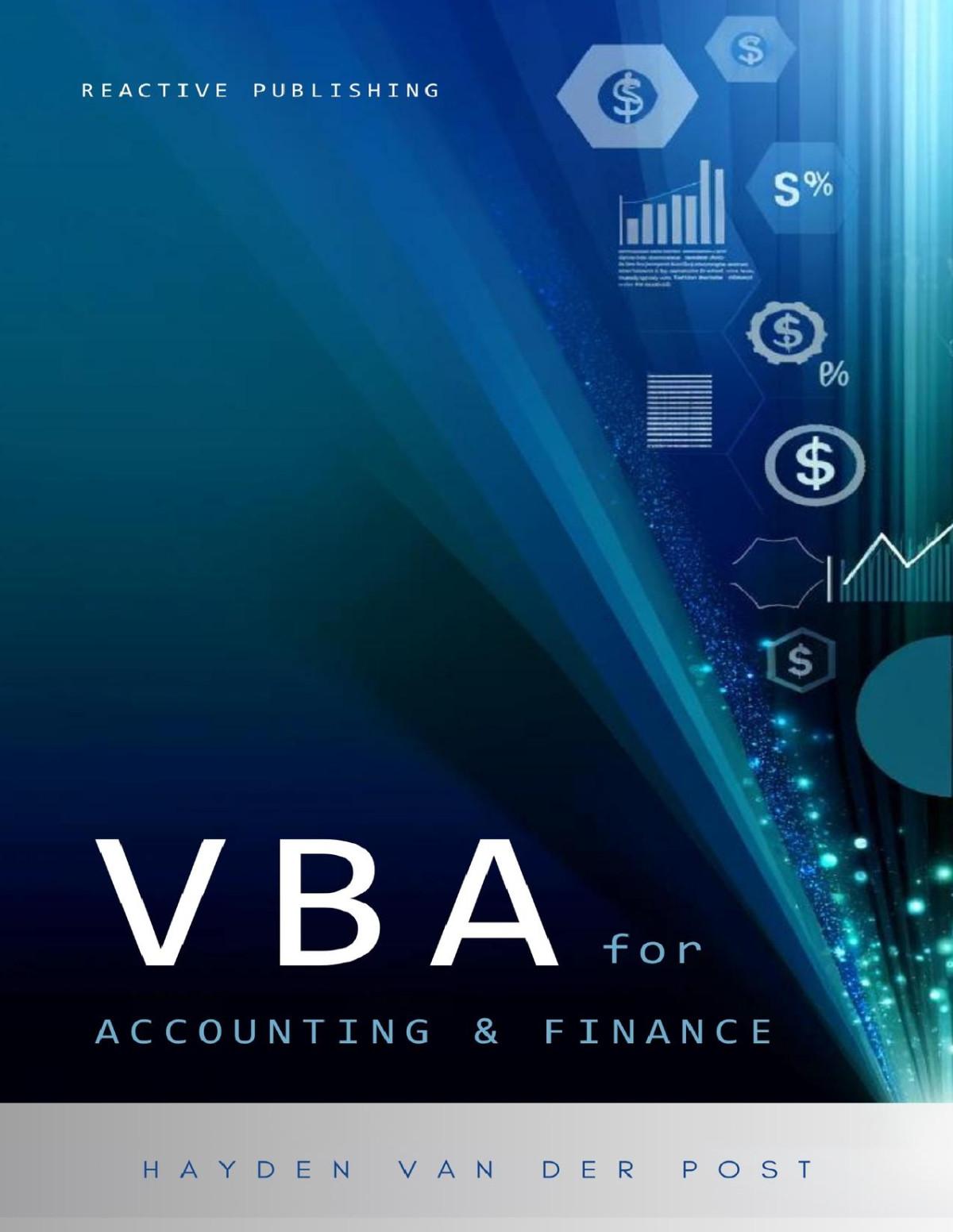Visit to download the full and correct content document: https://ebookmass.com/product/learn-vba-programming-for-finance-accounting-a-con cise-guide-to-financial-programming-with-vba-schwartz/
More products digital (pdf, epub, mobi) instant download maybe you interests ...
VBA for Accounting & Finance: A crash course guide: Learn VBA Fast: Automate Your Way to Precision & Efficiency in Finance Strauss
https://ebookmass.com/product/vba-for-accounting-finance-a-crashcourse-guide-learn-vba-fast-automate-your-way-to-precisionefficiency-in-finance-strauss/
VBA Guru: Master the Art of Automation: A Comprehensive VBA Guide for Finance & Accounting Sampson
https://ebookmass.com/product/vba-guru-master-the-art-ofautomation-a-comprehensive-vba-guide-for-finance-accountingsampson/
Excel VBA Programming For Dummies 6th Edition Dick Kusleika
https://ebookmass.com/product/excel-vba-programming-fordummies-6th-edition-dick-kusleika/
Python Programming for Beginners: 2 Books in 1 - the Ultimate Step-By-Step Guide to Learn Python Programming Quickly With Practical Exercises Mark Reed
https://ebookmass.com/product/python-programming-forbeginners-2-books-in-1-the-ultimate-step-by-step-guide-to-learnpython-programming-quickly-with-practical-exercises-mark-reed/
Programming for Game Design: A Hands-On Guide with Godot 1st Edition Wang
https://ebookmass.com/product/programming-for-game-design-ahands-on-guide-with-godot-1st-edition-wang/
A Beginners Guide to Python 3 Programming 2nd Edition
John Hunt
https://ebookmass.com/product/a-beginners-guide-topython-3-programming-2nd-edition-john-hunt/
Python Mini Reference 2022: A Quick Guide to the Modern Python Programming Language for Busy Coders (A Hitchhiker's Guide to the Modern Programming Languages Book 3) Harry Yoon
https://ebookmass.com/product/python-mini-reference-2022-a-quickguide-to-the-modern-python-programming-language-for-busy-codersa-hitchhikers-guide-to-the-modern-programming-languagesbook-3-harry-yoon/
Programming for Game Design: A Hands-On Guide with Godot 1st Edition Wallace Wang
https://ebookmass.com/product/programming-for-game-design-ahands-on-guide-with-godot-1st-edition-wallace-wang/
Programming for Game Design: A Hands-On Guide with Godot 1st Edition Wallace Wang
https://ebookmass.com/product/programming-for-game-design-ahands-on-guide-with-godot-1st-edition-wallace-wang-2/
L E A R N V B A
P R O G R A M M I N G
For Finance & Accounting
Hayden Van Der Post
Reactive Publishing
To my daughter, may she know anything is possible.
CONTENTS
Title Page
Dedication
Chapter 1: Introduction to Advanced VBA in Finance
1.1 The Role of VBA in Modern Finance
1.2 Setting Up the Development Environment
1.3 Best Practices in VBA Coding
1.4 Understanding VBA Syntax and Structure
1.5 Advanced Excel Object Model
Chapter 2: Financial Data Analysis with VBA
2.1 Importing and Exporting Data
2.2 Data Cleaning and Transformation
2.3 Advanced Techniques for Data Analysis
2.4 Dynamic Reporting with VBA
2.5 Data Visualization and Charting Techniques
Chapter 3: VBA for Financial Modeling
3.1 Building Flexible Financial Models
3.2 VBA Functions for Financial Calculations
3.3 Automating Sensitivity and Scenario Analysis
3.4 Risk Analysis and Management with VBA
3.5 VBA Techniques for Optimization
Chapter 4: Automating Excel Tasks with VBA
4.1 Task Automation Basics
4.2 Advanced Workbook and Worksheet Management
4.3 Event-Driven Programming
4.4 Scheduling and Timing Tasks
4.5 Integrating Excel with Other Office Applications
Chapter 5: Error Handling and Debugging
5.1 Principles of Error Handling
5.2 Debugging Techniques for VBA
5.3 Writing Custom Error Handlers
5.4 Testing and Validation Techniques
5.5 Optimization and Performance Tuning
Conclusion
Glossary Of Terms
Additional Resources
1.1 THE ROLE OF VBA IN MODERN FINANCE
The significance of VBA in the finance sector is immense; it acts as the unseen force skillfully shaping extensive data sets, transforming mere figures into insightful analytics. Financial analysts extensively use Excel for a spectrum of daily activities, varying from basic to intricate tasks. VBA serves as the crucial link connecting elementary spreadsheet functions with elaborate financial models. It empowers users to create tailor-made solutions, capable of adjusting to the unpredictable dynamics of financial markets. This adaptability is key in an industry where change is constant and rapid, making VBA an essential tool for financial professionals seeking to stay ahead in their field.
Through VBA, analysts can automate routine processes, freeing up valuable time for more complex analyses. This automation is not just a time-saver; it also enhances accuracy, reducing the risk of human error in repetitive tasks. Furthermore, VBA’s ability to handle large datasets efficiently makes it an ideal tool for financial modeling and forecasting. By leveraging VBA’s robust features, finance professionals can develop models that are both dynamic and reliable, capable of simulating various market scenarios and analyzing potential outcomes.
Consider the burgeoning field of real-time analytics, where financial markets fluctuate with a rapidity that demands agility and precision. VBA scripts can be devised to fetch and process market data swiftly, allowing
finance professionals to react to changes with informed strategies. Moreover, VBA's ability to interface with other applications and databases enhances its utility, offering a unified platform for varied financial operations.
But VBA's influence extends beyond just data manipulation. In the world of financial modeling, VBA serves as a sculptor's tool, expertly crafting models that can forecast financial outcomes, evaluate risks, and simulate the impact of different financial scenarios. This is particularly valuable when testing the resilience of financial strategies against potential market upheavals or when seeking to optimize investment portfolios.
Beyond the individual analyst or trader, VBA's role scales up to the enterprise level, where it is utilized to streamline processes that were previously laborious and time-consuming. Tasks such as generating financial reports, reconciling accounts, and managing budgets are expedited through automation, freeing up time for finance teams to focus on strategic analysis and decision-making.
The role of VBA in modern finance also has a pedagogical aspect. Mastery of VBA is increasingly considered an essential skill for finance professionals. As such, knowledge of VBA can significantly enhance one's career prospects, serving as a testament to one's ability to navigate the increasingly technical landscape of the financial industry.
By the end of this chapter, the reader will not only appreciate VBA's role but will also be equipped with practical knowledge and examples showcasing how to harness its full potential. Whether you are an aspiring financial analyst or a seasoned professional, the insights gained here will be indispensable in navigating the digital currents of modern finance.
Automation in Financial Analysis
Consider the monumental task of financial forecasting. Automation through VBA scripts turns this once daunting endeavour into a streamlined process. By crafting algorithms that intelligently sift through historical data, these scripts can identify trends and project future financial states with a level of
accuracy and efficiency unattainable by human hands alone. This functionality is indispensable for organizations that must make swift, datadriven decisions in an ever-changing economic landscape.
Moreover, automation via VBA extends to risk analysis – a domain where the stakes could not be higher. With the adept use of Monte Carlo simulations and other statistical models, VBA allows for the rigorous testing of financial portfolios against a multitude of variables and scenarios. Such in-depth analysis is critical in quantifying potential losses and informing risk mitigation strategies, thereby safeguarding assets against the unpredictable moods of the market.
The operational benefits of automation are equally impactful. Recurring tasks such as data entry, report generation, and the reconciliation of accounts are transitioned from manual to automated systems. This not only mitigates the risk of human error but also liberates finance professionals to allocate their intellect to strategic endeavors rather than administrative obligations. As such, the time saved converts directly to value added, as employees engage more in high-level analysis, client interaction, and innovation – activities that yield growth and competitive advantage.
Consider the example of a monthly financial report. Using VBA, one can develop a macro that aggregates data from various sources, performs necessary calculations, and formats the results into a comprehensive report, all with the click of a button. This automation ensures consistency in reporting, timely delivery of insights, and the capacity for real-time updates, thus enhancing the decision-making process.
Let us dive deeper and develop a VBA macro that automates the generation of a financial report. Suppose we have a dataset of monthly sales figures over the past year and seek to create a summary report showcasing total sales, average monthly sales, and a comparison with the previous year's performance. Here's how such a macro might look:
Dim ws As Worksheet
Set ws = ThisWorkbook.Sheets("Sales Data")
' Define the range containing sales data
Dim salesRange As Range
Set salesRange = ws.Range("B2:B13") ' Assume sales data is in B2:B13
' Calculate total sales
Dim totalSales As Double totalSales = Application.WorksheetFunction.Sum(salesRange)
' Calculate average monthly sales
Dim averageSales As Double averageSales = Application.WorksheetFunction.Average(salesRange)
' Compare with previous year's sales
Dim previousYearSales As Double previousYearSales = ws.Range("C14") ' Assume previous year's total is in C14
' Create a new worksheet for the report
Dim reportSheet As Worksheet
Set reportSheet = ThisWorkbook.Sheets.Add(After:=ThisWorkbook.Sheets(ThisWorkbook.S heets.Count))
reportSheet.Name = "Monthly Sales Report"
' Populate the report
With reportSheet
.Range("A1").Value = "Financial Sales Report"
.Range("A2").Value = "Total Sales:"
.Range("B2").Value = totalSales
.Range("A3").Value = "Average Monthly Sales:"
.Range("B3").Value = averageSales
.Range("A4").Value = "Year-over-Year Comparison:"
.Range("B4").Value = (totalSales - previousYearSales) / previousYearSales
End With ' Format the report With reportSheet.Range("A1:B4")
.Font.Bold = True
.Columns.AutoFit
End With
MsgBox "Financial report generated successfully!", vbInformation End Sub
The above macro provides a simple yet powerful illustration of automating financial analysis. It encapsulates the gathering, processing, and presentation of critical financial data, thereby serving as a foundational tool in the modern financial analyst's arsenal.
With automation, the potential of VBA to catapult financial analysis into new heights of sophistication and relevance is limitless. As financial professionals become ever more adept at leveraging these tools, they unlock new possibilities for innovation, strategic planning, and ultimately, the realization of their organization’s fullest potential.
Custom Functions for Financial Modeling
The heart of bespoke financial analysis lies in the creation of custom functions tailored to unique modeling requirements. A financial model is a
living sculpture, and VBA is the chisel that allows one to carve out precision and adaptability within Excel. The ability to encapsulate complex calculations into VBA functions empowers the user to streamline workflows, enhance reproducibility, and deploy models that can respond dynamically to a myriad of financial scenarios.
Let's turn our gaze to the complex construction of a user-defined function (UDF) that calculates the net present value (NPV) of a series of cash flows occurring at irregular intervals. This situation often arises in project finance and investment appraisal, proving too complex for Excel's built-in NPV function, which assumes a constant period between cash flows.
Here is an example of a VBA UDF that tackles this challenge:
Function IrregularNPV(discountRate As Double, cashFlows As Range, dates As Range) As Double
Dim npv As Double
Dim i As Integer
' Ensure matching sizes of cash flow and date ranges
If cashFlows.Cells.Count <> dates.Cells.Count Then
IrregularNPV = CVErr(xlErrValue)
Exit Function
End If
For i = 1 To cashFlows.Cells.Count
Dim cashFlow As Double
Dim date As Date
Dim period As Double
cashFlow = cashFlows.Cells(i).Value
date = dates.Cells(i).Value
' Calculate the period in years from the first cash flow date
If i = 1 Then
period = 0
Else
period = (date - dates.Cells(1).Value) / 365
End If
' Update the NPV with the discounted cash flow
npv = npv + (cashFlow / ((1 + discountRate) ^ period))
Next i
IrregularNPV = npv
End Function
```
By invoking this IrregularNPV UDF in Excel, finance professionals can effortlessly evaluate investments with cash flows that don't conform to standard timing. This UDF demonstrates the power of VBA in transcending the boundaries of Excel's native functions, offering a level of customizability essential for nuanced financial decision-making.
Besides the sheer computational power, custom functions in VBA proffer another strategic boon: the concealment of proprietary algorithms. Complex functions that embody a company's competitive analytical edge can be safeguarded within VBA, away from prying eyes, while still being readily accessible to authorized personnel via a simple function call.
As we explore further, consider a UDF that captures the essence of real options analysis, a technique that values the flexibility inherent in management's decision-making in response to market changes. Real options analysis is pivotal in strategic investment decisions, yet no standard Excel function can readily accommodate its complexity.
```vba
Function RealOptionValue(cashFlow As Double, volatility As Double, riskFreeRate As Double, timeToMaturity As Double) As Double
' Implementing the Black-Scholes option pricing model for real options
Dim d1 As Double
Dim d2 As Double
Dim optionValue As Double
d1 = (Log(cashFlow / riskFreeRate) + (riskFreeRate + (volatility ^ 2) / 2) * timeToMaturity) / (volatility * Sqr(timeToMaturity))
d2 = d1 - volatility * Sqr(timeToMaturity)
' Using the cumulative distribution function of the standard normal distribution
optionValue = cashFlow *
Application.WorksheetFunction.Norm_S_Dist(d1, True) - riskFreeRate * Exp(-riskFreeRate * timeToMaturity) * Application.WorksheetFunction.Norm_S_Dist(d2, True)
RealOptionValue = optionValue End Function
The RealOptionValue function is a VBA distillation of the Black-Scholes model, adapted for real options. This example showcases how VBA extends Excel's capabilities into the world of sophisticated financial theory, enabling analysts to become architects of their analytical destinies.
Data Processing and Management
Data processing in VBA encompasses a vast array of activities: from extracting and importing data from various sources to validating its integrity and transforming it into meaningful insights. Consider, for
example, the task of consolidating financial statements from multiple subsidiaries into a parent company's ledger. The sheer volume and variety of data can be overwhelming, but with VBA, one can automate these processes, reducing the risk of human error and freeing up valuable time for analysis.
Imagine you're tasked with collating quarterly revenue figures from various branches, each providing their data in different Excel files. Here is how you might automate the consolidation with VBA:
```vba Sub ConsolidateFinancials()
Dim wsTarget As Worksheet
Dim wsSource As Worksheet
Dim revenueRange As Range
Dim lastRow As Long
Dim file As Variant
Dim filePaths As Collection
Set filePaths = New Collection
' Add the file paths of the branch workbooks to the collection
filePaths.Add "C:\FinancialData\Branch1.xlsx"
filePaths.Add "C:\FinancialData\Branch2.xlsx"
filePaths.Add "C:\FinancialData\Branch3.xlsx"
' Add more file paths as needed...
' Set the target worksheet where data will be consolidated
Set wsTarget = ThisWorkbook.Sheets("Consolidated Revenues")
' Initialize the target row for the first set of data
lastRow = wsTarget.Cells(wsTarget.Rows.Count, "A").End(xlUp).Row + 1
' Loop through each file path and import the revenue data
For Each file In filePaths
' Open the source workbook and set the worksheet
Workbooks.Open file
Set wsSource = ActiveWorkbook.Sheets("Quarterly Revenue")
' Find the range of revenue data
Set revenueRange = wsSource.Range("B2:B" & wsSource.Cells(wsSource.Rows.Count, "B").End(xlUp).Row)
' Copy the revenue data to the target worksheet revenueRange.Copy wsTarget.Cells(lastRow, "A")
' Update the last row for the next data set lastRow = lastRow + revenueRange.Rows.Count
' Close the source workbook without saving ActiveWorkbook.Close False
Next file
End Sub
This subroutine elegantly automates the retrieval of revenue figures from separate workbooks, depositing them into a single, consolidated worksheet. The script reduces the task from potentially hours of manual labor to a mere button press.
Furthermore, data management in VBA extends to organizing and maintaining data integrity. It is not uncommon to encounter datasets tainted with duplicates, errors, or missing values—maladies that can lead to faulty analyses and misguided decisions. With VBA's data cleansing functionalities, financial analysts can implement routines to sift through datasets, excising inaccuracies and irregularities with surgical precision.
Consider the implementation of a macro that identifies and removes duplicate entries based on a specific key, such as a transaction ID: ```vba
Sub RemoveDuplicates()
Dim ws As Worksheet
Set ws = ThisWorkbook.Sheets("Transaction Data")
' Define the range to remove duplicates from (assume data starts in A2)
Dim dataRange As Range
Set dataRange = ws.Range("A2", ws.Cells(ws.Rows.Count, "A").End(xlUp))
' Remove duplicates based on the first column (Transaction ID) dataRange.RemoveDuplicates Columns:=1, Header:=xlNo
End Sub
By deploying this simple yet efficient macro, financial operatives can ensure the cleanliness and reliability of their data, promoting confidence in the subsequent analyses.
Integrating VBA with Financial Platforms
Financial platforms, with their unique ecosystems, often come replete with proprietary functionalities tailored for specific financial tasks. However, these platforms may not natively interact with one another or with custom user workflows. This is where VBA's integration prowess shines, as it allows for the customization and extension of platform capabilities, fostering a seamless flow of data and operations.
Let's consider the integration of VBA with a common financial platform, such as Bloomberg Terminal, which is a staple in many financial institutions for real-time market data, financial analysis, and trading
operations. By using VBA, one can automate the process of retrieving specific data points from Bloomberg and manipulate them within Excel for further analysis or reporting.
Here is an illustrative example of how VBA can be used to retrieve the latest stock prices from Bloomberg Terminal and insert them into an Excel spreadsheet:
```vba Sub RetrieveBloombergData()
Dim BloombergApp As Object
Dim securities As Variant
Dim fields As Variant
Dim results As Variant
Dim ws As Worksheet
Set ws = ThisWorkbook.Sheets("Market Data")
' Define securities and fields
securities = Array("AAPL US Equity", "GOOG US Equity", "MSFT US Equity")
fields = Array("PX_LAST") ' Last price field
' Establish a connection to Bloomberg Terminal
Set BloombergApp = CreateObject("Bloomberg.Data.1")
' Request data for the specified securities and fields results = BloombergApp.BDP(securities, fields)
' Insert the data into the worksheet
Dim i As Integer
For i = LBound(results) To UBound(results)
ws.Cells(i + 1, 1).Value = securities(i)
ws.Cells(i + 1, 2).Value = results(i)
Next i
End Sub
The above subroutine demonstrates how VBA can interact directly with Bloomberg Terminal's data objects to fetch the latest stock prices and record them in an Excel sheet. Such automation can be scheduled or triggered as needed, ensuring that financial analysts always have access to the most current data.
Integration extends beyond data retrieval. VBA can also be instrumental in feeding data back into financial platforms or executing trades. For instance, VBA scripts can be crafted to interact with trading platforms, such as Interactive Brokers or MetaTrader, to automate trade execution based on predefined strategies or signals detected within Excel models.
Consider the example of a VBA macro that might be used to place trades on the Interactive Brokers platform:
```vba Sub PlaceTradeOrder()
Dim IBApp As Object
Dim contract As Object
Dim order As Object
' Connect to Interactive Brokers' Trader Workstation (TWS)
Set IBApp = CreateObject("TWS.TwsCtrl.1")
' Define the contract details for the trade
Set contract = IBApp.CreateContract()
contract.Symbol = "AAPL" contract.SecType = "STK"
contract.Currency = "USD"
contract.Exchange = "SMART"
' Define the order details
Set order = IBApp.CreateOrder()
order.Action = "BUY"
order.OrderType = "LMT"
order.TotalQuantity = 100
order.LmtPrice = 150 ' The limit price for the trade
' Place the order
Call IBApp.PlaceOrder(contract, order)
End Sub
In this example, the VBA script establishes a link with Interactive Brokers' Trader Workstation, creates a contract and order object with the desired parameters, and places a buy order for 100 shares of Apple at a limit price of $150 per share.
Integrating VBA with financial platforms transforms the capabilities of finance departments, enabling automated workflows that were previously inconceivable. Beyond the examples provided, the potential applications are vast, limited only by the boundaries of the platforms themselves and the creativity of the VBA developer.
VBA versus Other Programming Languages in Finance
The choice of programming language in the finance sector is a pivotal decision that hinges on several factors, including the task at hand, the existing technological infrastructure, and the strategic direction of the organization. While VBA has been a stalwart companion for many finance professionals, other languages have emerged and staked their claim in the financial programming landscape.
VBA, with its deep integration into Microsoft Office products, particularly Excel, is a natural fit for financial modelling and analysis tasks that require manipulation of spreadsheet data. Its ease of use and widespread adoption have made it the go-to language for many ad-hoc financial tasks and automations. Specifically, VBA excels in scenarios where quick development and deployment within the Office ecosystem are paramount.
However, when we venture into more complex domains such as highfrequency trading algorithms, large-scale data analysis, or machine learning, languages such as Python, R, C++, and Java come into play. These languages bring their own strengths and cater to different aspects of financial programming.
Python stands out as the leading contender due to its simplicity, readability, and an extensive collection of libraries for data analysis, such as pandas, NumPy, and SciPy, as well as machine learning frameworks like scikit-learn and TensorFlow. Python's versatility makes it an excellent choice for a wide range of financial applications, from quant finance to risk management and beyond.
For instance, let’s consider a Python script that calculates the moving average convergence divergence (MACD), a popular technical indicator used in stock market analysis:
```python import pandas as pd
import pandas_datareader as pdr
import datetime
# Define the stock symbol and date range
stock_symbol = 'AAPL'
start_date = datetime.datetime(2020, 1, 1)
end_date = datetime.datetime.now()
# Fetch historical stock prices
data = pdr.get_data_yahoo(stock_symbol, start_date, end_date)
# Calculate MACD
exp1 = data['Adj Close'].ewm(span=12, adjust=False).mean()
exp2 = data['Adj Close'].ewm(span=26, adjust=False).mean()
macd = exp1 - exp2
signal_line = macd.ewm(span=9, adjust=False).mean()
data['MACD'] = macd
data['Signal Line'] = signal_line
In the above Python code snippet, we utilize pandas for fetching and processing the stock price data and then calculate the MACD indicator. Python's ability to handle such tasks with relative ease makes it a formidable tool for financial analysis.
R, on the other hand, is a language tailored for statistical analysis and visualizations, making it well-suited for tasks that involve complex statistical computations and modelling.
C++ is chosen for its performance and is often used in areas where execution speed is critical, such as in high-frequency trading platforms. Java also finds its place in the finance sector due to its robustness, portability, and scalability, which are essential for enterprise-level applications.
As we delve into these comparisons, it is not to say that one language is definitively superior to another. Each has its niche, and the most effective financial technologists are those who can leverage the right tool for the job, sometimes even combining languages to harness their collective strengths.
This chapter will rigorously dissect the pros and cons of VBA compared to these other languages in various finance-specific scenarios. We will explore case studies and examples where different languages may be more
appropriate, and how they can complement VBA rather than simply replace it.
By understanding the interplay between these programming languages, you will be better equipped to make informed decisions regarding their use in your financial projects. This knowledge will empower you to architect solutions that are not only technically sound but also strategically aligned with your organization's objectives and the ever-evolving landscape of financial technology.
Embrace this exploration as an opportunity to expand your technical toolkit and become a versatile finance professional capable of navigating the rich mosaic of programming languages that shape the finance industry today.
1.2 SETTING UP THE DEVELOPMENT ENVIRONMENT
Firstly, we need to ensure that we have access to the Developer tab in Excel, which is not displayed by default. To make this tab visible, you must:
1. Click on the 'File' tab and choose 'Options.'
2. In the 'Excel Options' dialog box, select 'Customize Ribbon.'
3. Check the 'Developer' checkbox in the right pane and click 'OK.'
Now that the Developer tab is available, we can proceed to configure the Excel environment specifically for financial VBA development. The following steps are foundational:
- Excel Setup for Advanced Users: Tailor Excel's options to optimize the performance for handling large datasets. This involves adjusting settings such as disabling automatic calculations for complex workbooks, which can be done through the 'Formulas' tab in 'Excel Options,' and selecting 'Manual' under 'Calculation options.'
- Security Settings for Macros: Given the sensitive nature of financial data, security is paramount. Initial steps involve setting macro security levels to prevent unauthorized code execution. Navigate to 'Macro Settings' under
the 'Trust Center' settings in 'Excel Options' and select an appropriate level, such as 'Disable all macros with notification.'
- Add-ins and COM Add-ins: Enhance your VBA capabilities by installing relevant add-ins. In the 'Add-ins' section of the 'Developer' tab, you can manage Excel and COM add-ins. Add-ins like Analysis ToolPak are particularly useful for performing complex financial analyses.
- Useful Developer Tools: Familiarize yourself with the VBE (Visual Basic for Applications Environment) and its array of tools. Access VBE by pressing `ALT + F11`. Within VBE, explore the 'Project Explorer,' 'Properties Window,' and 'Immediate Window'—tools that are indispensable for effective debugging and code navigation.
- Debugging and Error Handling Basics: An integral part of a robust development environment is the ability to troubleshoot and handle errors efficiently. Learning to leverage the debugging tools such as 'Breakpoints,' 'Step Into,' and 'Watch Window' is crucial in maintaining the integrity of your financial models.
With the development environment set up, let's proceed with an example showcasing how VBA can interact with Excel to create a simple macro that automates a financial routine, such as consolidating monthly expense reports:
Sub ConsolidateExpenses()
Dim wsSummary As Worksheet
Dim wsMonth As Worksheet
Dim i As Integer
' Create a new summary worksheet
Set wsSummary = ThisWorkbook.Sheets.Add wsSummary.Name = "Expense Summary"
' Loop through each worksheet and copy data to the summary sheet
For Each wsMonth In ThisWorkbook.Worksheets
If wsMonth.Name <> "Expense Summary" Then i = i + 1
wsMonth.Range("A1:B10").Copy Destination:=wsSummary.Range("A" & (i * 10))
End If Next wsMonth
MsgBox "Monthly expenses consolidated successfully."
End Sub
In the VBA snippet above, we iterate through all worksheets in the Excel workbook, copying a predefined range from each sheet into a newly created summary sheet. This simple yet practical example demonstrates the potential for automation in financial processes.
Security settings for macros
Macro security settings in Excel are accessed via the 'Trust Center.' The following configurations are recommended for advanced users who regularly engage with VBA:
- Macro Security Levels: Excel provides several levels of macro security, ranging from 'Disable all macros without notification' to 'Enable all macros.' The most secure and commonly recommended setting for finance professionals is 'Disable all macros with notification.' This option ensures that you are alerted each time a workbook containing macros is opened, allowing you to enable them on a case-by-case basis.
- Trusted Locations: Establish trusted locations on your system where macros can run without being subject to the usual security restrictions. This is particularly useful for directories where you frequently access and run
your VBA code. However, caution is advised to ensure these locations are secure and not exposed to untrusted sources.
- Trusted Documents: Excel allows you to 'trust' documents that you have deemed safe. Once a document is trusted, macros will run without prompting security warnings. This streamlines workflow for documents you use regularly while maintaining a high security standard for new or unverified files.
- Digital Signatures: Utilize digital signatures to confirm the authenticity and integrity of macros. A digital signature assures the user that the code has not been altered since it was signed. For macros developed in-house, consider using a self-signed certificate. For broader distribution or higher trust requirements, obtaining a certificate from a reputable certification authority is advisable.
- Password Protection: Protecting your VBA code with passwords prevents unauthorized users from accessing or altering your macros. While not infallible, password protection adds a layer of security that can deter casual snooping and protect against accidental changes by well-intentioned users.
- User Prompting and Consent: For macros that require high levels of trust, consider implementing user consent protocols. Before executing critical operations, prompt the user for confirmation or additional authentication. This step can prevent unintended actions and ensure that the user is cognizant of the macro's functions.
Moreover, it is important to maintain a culture of security awareness among all users who interact with your financial models. Educate team members on the risks associated with macros and the reasons behind the security measures in place. Encourage vigilance and the reporting of any suspicious behavior or unexpected macro executions.
By meticulously following these security practices, you can strike a balance between the advanced functionality that VBA offers and the imperative to protect your financial models and data. In the upcoming sections, we will build upon these security foundations, exploring how to leverage Excel and
VBA’s full potential while maintaining steadfast security and control over your financial computational environment.
Add-ins and COM add-ins
Add-ins and COM Add-ins are powerful extensions in Excel that enhance its native capabilities with custom functionality specifically designed for financial analysis and modeling.
Add-ins are supplemental programs that, once installed, become seamlessly integrated into Excel, contributing additional commands and features. Financial professionals often rely on Add-ins for specialized tasks such as statistical analysis, advanced charting, or complex data manipulation. To leverage an Add-in effectively:
- Installation and Management: Access the 'Add-ins' section through Excel's 'Options' menu. You can browse available Add-ins, manage installed ones, or navigate to the 'Add-in Manager' to install new ones. Always source Add-ins from trusted developers and verify their compatibility with your version of Excel.
- Usage and Functionality: After installation, familiarize yourself with the Add-in's features. Many Add-ins come with dedicated ribbons or toolbar buttons, granting quick access to their functions. Take time to explore the documentation and tutorials provided by the developer to fully exploit the Add-in's capabilities.
- Custom Add-ins: For finance-specific requirements not met by commercial Add-ins, consider developing custom Add-ins. This could involve writing functions to automate bespoke calculations or to interface with proprietary financial systems. Custom Add-ins can provide a competitive edge by fine-tuning Excel to your firm's methodologies.
COM Add-ins represent a more advanced and versatile class of extensions. Created using more robust programming languages like C++ or C#, they can interact with multiple applications beyond Excel, offering integration across the Office suite and beyond:
- Integration and Interoperability: COM Add-ins can work across different Office applications, allowing for a unified experience when working with data in Excel, Word, and Access. This is particularly useful for financial professionals who need to maintain data consistency and workflow integration across various documents and reports.
- Performance and Complexity: Given their potential for higher performance and greater complexity, COM Add-ins are well-suited for intensive tasks such as real-time data processing, complex simulations, or interaction with external financial databases and APIs.
- Deployment and Security: Deploying COM Add-ins typically requires administrative privileges due to their deep integration with the system. This necessitates a thorough security assessment and adherence to best practices for deployment, versioning, and updates to prevent compatibility issues or security vulnerabilities.
To manage COM Add-ins, navigate to the 'COM Add-ins' dialog box from the 'Trust Center' in Excel. Here you can add, remove, or update COM Addins, ensuring they align with your current project requirements and security protocols.
As we progress, remember that the true power of these extensions lies in their ability to be tailored and adapted to the unique challenges and opportunities within the financial sector. The upcoming chapters will provide comprehensive insights into harnessing these tools to their fullest potential, always with a view towards sophistication, security, and superior financial analysis.
Useful Developer Tools
The Visual Basic for Applications (VBA) Editor, or the Integrated Development Environment (IDE), is the nucleus of development within Excel. Its robust set of features allows for the creation, editing, and debugging of VBA code. Key components of the VBA Editor include:












